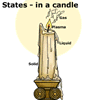In the first part of Rates
of chemical reactions - mechanisms, five factors which affect the
speed of a chemical reaction were identified:
- Reaction complexity.
- Activation energy of the reaction - energy required for the reaction
to occur.
- The state of the reactants, i.e. solid, liquid, solution or gas.
- The temperature at which the reaction occurs.
- The presence of a catalyst or enzyme.
Reaction complexity
The more complex the reaction, the slower it tends be. If the reaction
involves large molecules and a complex series of transformations, like
the formation of protein in a cell, then the reaction tends to be slow.
If the reaction is a simple one, involving the collision of two atoms
or small molecules and their joining to form a new substance, then the
reaction tends to be quick.
The following animation shows a hydrogen atom and chlorine atom combining
to form HCl. Although very much simplified compared to the most reactions,
this shows the simplist possible type of interaction - two atoms colliding
to form a molecule.

|
Formation of HCL |
Activation energy
To allow particles to react with one another, the reacting particles must
collide with enough energy to overcome any initial repulsion between themselves
and join together. The activation energy is the energy required to overcome
this initial repulsion.
Activation energy is quite often depicted as a hill, with only the fastest
moving particles able to get over the hill and react. Those with too little
energy, simply bounce off each other! The higher the activation energy
hill the slower the reaction.

|
Activation energy hill |
The state of the reactants
 Put
simply, the more movement the reactant particles have, the faster they
will react. Gases tend to react faster than liquids and liquids react
much faster than solids. Liquid petrol is vaporised before exploding in
an internal combustion engine. If you look carefully at a burning candle
you will see that the fastest reaction (the burning) occurs around the
wick, where the solid wax has been melted to form a liquid and then vaporises
before burning.
Put
simply, the more movement the reactant particles have, the faster they
will react. Gases tend to react faster than liquids and liquids react
much faster than solids. Liquid petrol is vaporised before exploding in
an internal combustion engine. If you look carefully at a burning candle
you will see that the fastest reaction (the burning) occurs around the
wick, where the solid wax has been melted to form a liquid and then vaporises
before burning.
The temperature
It is true for all chemical reactions that the higher the temperature,
the faster they react. The hotter the surroundings of the reaction, the
faster the particles will be moving and the more energy they will have
and the more particles will collide with enough energy to get over the
activation energy hill and react. This all adds up to faster reactions.
Catalysts
Catalysts are substances which speed up chemical reactions without being
used up in the reaction themselves. Catalysts work by helping the reactant
particles come together in the right orientation for reaction and by lowering
the energy required for the reaction to occur. An enzyme is an example
of a biological catalyst.
Platinum is an excellent catalyst for many gaseous reactions. Platinum
wire placed in a mixture of hydrogen and oxygen gas will make it explode,
a dramatic increase in the rate of reaction!

|
Catalytic reactions |
|
Slow
|
|
Fast
|
|
complex molecules
|
liquids
|
simple ions, atoms and molecules
|
|
high activation energy
|
low activation energy
|
|
|
solids
|
gases
|
|
|
cold
|
hot
|
|
|
catalysts and enzymes
|
| Copyright owned by the State of Victoria (Department of Education and Early Childhood Development). Used with Permission. |